The Wisconsin Experience in Motion: Physical Therapy in Belize
Since returning home I have been thinking about our experience in Belize and just how valuable each activity was — for us as students and faculty, and, according to the SNAT members at our final dinner with them this past Friday, to the community of Punta Gorda.
The school visits: We were able to have contact with children and sensitize them to the many things people with disabilities can do. Our faculty was also able to speak with some of the teachers and make contacts with the special needs instructors (who have no formal instruction, but improvise how to treat in a classroom) and follow up to offer suggestions of how to better work with children in the classroom.
This also opened our eyes to how different each school was. It was obvious which schools tended to send more children to high school and college vs. the ones where education usually stops after sixth grade.
The community talks allowed us to speak one-on-one with families from the Punta Gorda area who had concerns about family members and were searching for new answers. We had to think on our feet as students; the faculty offered further information and suggestions to ease quality of life and further progress children; everyone shared personal stories of caring for a loved one with autism, cerebral palsy, a stroke or an intellectual impairment.
Holding an ortho clinic opened our eyes to some of the common injuries of workers in Punta Gorda. Everything was a work-related injury from poor mechanics, a trauma or from overuse for years. One example of something I think is taken for granted in the U.S. is the accessibility of surgery — if you have severe osteoarthritis you will have some form of a knee replacement and then have another when your first wears out — but unless a family has resources to go to another country and they are able to miss work, that family member will continue working on their degenerating joints as long as they live.
Home visits opened our eyes to not only the living quarters of some of the families in Punta Gorda, but also the warmth among family members, which was demonstrated to us in spite of not always being able to comply with therapy. There were three families that I saw that stood out to me: One man with a stroke who complied 100 percent but was probably not able to ever return to Placencia to fish with his son; one family with three children with completely different forms of cerebral palsy — that mother was always doing laundry, feeding her children or cooking for her family from scratch, including squeezing coconut shavings for milk to make tortillas; and, finally, one boy who had some form of muscular dystrophy who was completely normal cognitively but because there were 11 children in this family, including one newborn, this 16-year-old has been lying in a bed (cardboard on a wood bed frame) for the past five years and is not afraid to sit up although he needs position changes to avoid sores and infections. What other class experience could offer this sort of real-life eye-opening?
Adapting a wheelchair with few resources was a lot of fun, because you had to think on your feet and improvise. Everyone who gets a wheelchair gets the same generic seating system, so armed with Velcro, foam, kitchen knives, a sewing kit and various types of cloth, we made a chair more supportive for a girl with no trunk or head/neck control.
What struck me about the storage shed was how much wonderful equipment was donated! Unfortunately, there were a lot of supplies that were not appropriate for the possible services provided at the clinics. Now there is a wish list for therapy supplies so hopefully there will be more applicable to therapy and medical needs in Punta Gorda. For example, there are not many tennis-elbow problems or casting that goes on at the clinics, but there were a lot of supplies for both.
There is no other way I can imagine learning so much in so short a time. I do hope students next year are able to return with some further tweaking of the schedule — not just for the students, but for some continuity of care for the families we saw, and for the special needs instructors to continue better serving students. This was a fantastic experience and I am so thankful I was able to go!
Sally
Jan. 16, 2009
I wanted to take this opportunity to discuss the two site improvement projects we are completing here at Hillside, which were funded by our student organization, Phi Theta, and a couple of the faculty.
The two projects are building a wheelchair ramp for the clinic and repairing some termite damaged walls of the medical supply storage building. The resident handyman, Evert (who also happens to be the local mayor), has been instrumental in getting the projects underway.
The building that houses the medical supplies is two stories with the second floor serving as living quarters for full-time volunteers. Like many buildings in the area, it is constructed of large steel-reinforced concrete pillars that support the second floor. Since they frequently receive heavy rainfall, homes in low lying areas won’t have the first floor finished off to avoid damage from flood waters.
The clinic is on a side of a hill, so in a relatively dry spot. The walls between the pillars were initially constructed of untreated lumbar and termites have spent the last several years hollowing them out to the point where the paint on the outside is about the only thing holding them together.
Prior to replacing the walls with treated lumbar, we took on the tedious task of cleaning, taking inventory and organizing the building and medical supplies. Since the walls are non-weight bearing, they are actually quite simple to replace. Some priority maintenance issues like leaky faucets and a huge infestation of fleas under the dorm from all of the mangy dogs that sleep under there to stay dry have set back the building project, but we should easily be able to finish that tomorrow.
A ramp to the clinic was definitely needed because they previously had been lifting patients up the steps to the building if they were wheelchair bound. Evert poured the ramp today with one of his friends.
We were in Punta Gorda all day conducting an orthopedic clinic at the hospital and home visits in town so I, unfortunately, didn’t get to help with that project. I can take solace in the fact that I did get to design the layout of the ramp and it looks great, if I do say so myself.
Ed
Jan. 16, 2009
Well, our time in Belize is nearing the end. We have had lots of rain — in fact we learned late on Wednesday there is a bridge out between Punta Gorda and Belize City (4 hours away). That is the only paved road. Luckily we have been able to book a flight on a very small plane from Punta Gorda to Belize City. We will be in a total of five different airports tomorrow!
We were able to join a Mayan family (11 children!!!) for a tortilla and basket making demonstration. I think I was better at the tortilla making than the basket making — both were more challenging than they looked. We had lunch (we ate the tortilla’s we made!) and headed back to our village.
There was another round of home visits and an ortho clinic at the hospital. We have managed to stay very busy despite the rain! Tonight is our final event with SNAT. We are looking forward to celebrating the success of our two week venture into this beautiful country.
The experience has been full of twists and turns. The students have been a stellar group. They have represented our university with honor, and I have been proud to share these two weeks of their lives. The faculty were a constant source of information and challenges — the students rose to every challenge and in the end will be better physical therapists!
Probably most important — each of us on this trip has been impacted. Whether it was a client, a community member, a student or a nurse — we have been touched by the people of Belize.
We are all looking forward to our return to Wisconsin! See you soon.
Lori
Jan. 14, 2009
Hello again! Yesterday was the day that we got to see how our wheelchair creations worked for the children.
We got Brittany into her wheelchair so that she was safe and able to hold her head up. We took her for a walk down the street. We were told that her mom was tearing up. It will be such a relief for her to not have to hold her all day and be able to take her into the community.
We also had to make some modifications to a stroller for another child, Svena. This was more challenging, as we had to problem-solve what adaptations we needed to make on site and with only the equipment we brought with us. Needless to say, there was a lot of trial and error before we found something that would work for her. It is not perfect but we have someone to follow up with her after we leave, and our modifications are an improvement. Her stroller is now safer, and she is positioned better in it.
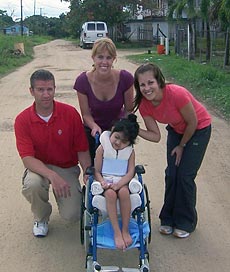
Ed, Becca and Rachel with Brittany after modifications to her chair.
We have seen so many parents here that have been so dedicated to helping their children even though there are such limited resources. Both of the families that we made the modifications for had attended our adult-education sessions to better understand how to help their children. The simple modifications and minimal education that we gave them were able to make such a huge difference in their lives and improve the comfort and safety of their children.
See you in three days!
Becca, Ed, Rachel and Sally
Jan. 14, 2009
Greetings. A quick note: I was able to accompany the students and faculty into three homes to bring equipment to assist the children. There were at times six of us crowded into very little space. The families always were welcoming and friendly — sharing what little space they had with us.
One family has three children with disabilities. The disabilities range from moderate to severe. None of the children are able to walk. Only one can sit. The home is small, perhaps 12-by-12. It had three beds and a little space to walk around, but nothing else. The students worked with each of the three children and eventually persuaded Tanika to get into a wheelchair. The students also created a positioning pillow for the other children to assist them in sitting. It was powerful to watch the children respond to the hands-on approach of the students.
Take care,
Lori
Jan. 13, 2009
Greetings again from Sally,
As time rolls on here in Belize, the biggest culture shock for me, has been with regards to the sense of time here and keeping a schedule — or lack thereof. It has become a running joke in the group when making plans that, for example, we will do the community talks from 4-5 p.m. Belizean time, which means we will probably start at least 30 minutes late, and people will roll in even later, and many people remain after the talk to engage more.
An example of this could be today, while trying to plan our day when we planned to start building the wheelchair ramp and organize the storage shed full of physical therapy supplies, our schedule ended up being planned out as, “We’ll do what we need in town in the morning, maybe start organizing or maybe eat lunch and organize in the afternoon, then finish up MacGyvering a wheelchair as able — or whatever we do not get done today we can to tomorrow or Wednesday…”
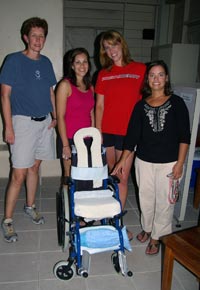
UW group members pose near a wheelchair that they helped to modify.
Maybe we are absorbing the laid-back culture? Maybe our schedule is getting lighter? It has amazed me that everything we planned to get done has been done, so far — especially with our group being the first group of physical therapists from the UW down here.
The sitting and waiting mentality and just letting what happens happen does make for a minimally stressful environment. This could be a result of the hot and humid climate coupled with poverty paired with malnutrition — the culmination of which lends to a more laid-back atmosphere.
One of the hopes in doing our adult education sessions was to get people to realize that there are many other families with children with disabilities and to help give them a voice — to help stand up for their children. Families want to be proactive and get together to actually make something happen for their children but are not sure how to or the struggle of their daily lives to not allow them to do so.
If SNAT (The Special Needs Association of Toledo) becomes a stronger presence in the community, then perhaps something like this could happen. One of our goals of this trip was to assist SNAT in building their reputation in the Toledo district. I hope we are able to lay the foundation and help get the ball rolling!
Sally
Jan. 12, 2009
On Friday morning (Jan. 9), we did our last school visit at the Little Flower School. Again it was a school outside of Punta Gorda, and all of the kids were very well-behaved and interactive.
They had one student with a disability, and it was heart-warming to see how the other kids interacted and included him in everything. Needless to say, they were well-experienced in maneuvering the wheelchair. While reading books to the students and asking questions they were quick to respond. When asked what kind of music they thought the characters were dancing to, they exclaimed, “Punta Rock!”
This weekend we got a well-deserved break and headed out to an island off of Belize called Lime Caye. It truly was a piece of paradise once we got there. The boat ride was rough and left us with sore backs and bruised bottoms. On the island we swam with the fishes, sat on the beach, snorkeled, went island hopping, built a bonfire, made “Belizean s’mores” (consisting of cookies, chocolate frosting and marshmallows) and held a morning pilates session on the beach.
Our guide was very knowledgeable of the area and talked of the struggles to keep the reef and Belizean waters beautiful for years to come. Many unknowing visitors will drop anchor not knowing where the reef is and ruin the beautiful sea life. He viewed these visitors in a bittersweet light.
He also talked about the struggle between Belize and Guatemala and how progress is still to come. Like everyone we have met here, the Belizeans were proud to share their culture and love of the land and sea.
On Sunday evening (Jan. 11), after a much smoother boat ride home, the bronzed physical therapy crew went straight back to work adapting a wheelchair for a child seen the week before.
With limited supplies we constructed a seating system, head support, lateral supports, foot support and seatbelt for the chair. Everything was handmade with love, right down to the Velcro stitched on with a mini-sewing kit. It’s amazing what you can come up with when you put many creative minds together. We think the little girl will love it.
We have a busy week ahead of us, and we are happy to be safe from the snow emergencies at home!
Becca and Rachel
Jan. 12, 2009
In reflecting on my experience with the people of Belize thus far, I would have to say that I have been both a little surprised and impressed. I have been to several poor countries in my life, and Belize certainly isn’t the poorest of them, but there seems to be a very different attitude here.
That is to say that a very common theme I have seen in other countries is people with extended hands begging for money or pushing really hard to try to sell you something. In these engagements I have felt very little acknowledgement of me as a person, with the only focus being on the possibility that I may have money, and they must employ their best strategy to get me to part with it.
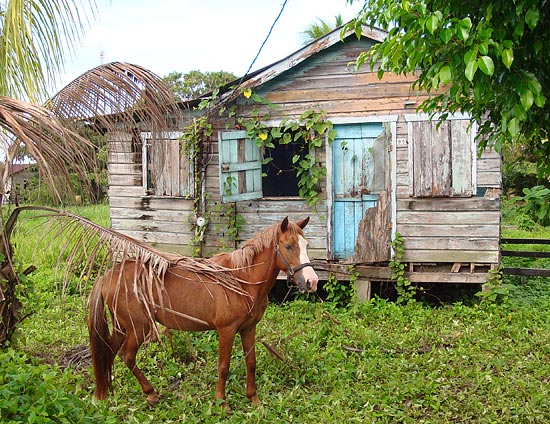
A home near Punta Gorda, Belize.
I completely understand that many of those people may be in a desperate situation, but I get frustrated with the lack of sustainable independent means that exists with handouts. This is the idea of give me a fish and you feed me for a day, teach me to fish and you feed me for a lifetime.
What I have seen from the people of Punta Gorda is the kind of friendliness seen only in small towns in the U.S. on occasion. As I walk down the street, nearly everyone smiles and says hello. I get feeling that people have a sense of community and are welcoming to outsiders.
In the five home visits for therapy services I have completed thus far, I have been very impressed with how welcoming and hospitable the patients and their families have been. Most of them are very poor and have had debilitating conditions for a long time, yet seem to have a positive attitude.
One possible reason for this is that they seem to have strong family support, with the whole family interested in the activities we do with their family member and what they can do to help. I wouldn’t go as far as saying that all Belizeans are kind and caring, but certainly the positive benefits they reap from doing so may be a valuable reminder to the people in the U.S.
Ed
Jan. 12, 2009
It is Monday, the beginning of our second week. The time has flown and stood still at the same time. The students and faculty have done clinics, given community education sessions, visited four different schools and participated in home visits with the Belizean people. The work has been rewarding and draining.
We left at 8 a.m. for a day and a half of fun on an island off the coast of Belize. It is owned by the Belizean government and leased to a family to run a primitive camping resort. It was a 1.5-hour boat ride to the island. The water was rough, and I was glad to have taken my motion-sickness pills!
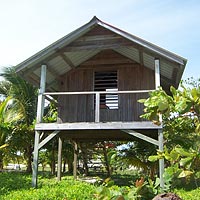
A camping shack on Lime Caye.
Once on the island — it was beautiful. White sand, crystal-clear water in hues of vivid blue and green — just what you would expect in the Caribbean! The accommodations were sparse, and as we learned in the middle of the night, a little creaky, but overall the experience was a positive one!
My highlights include seeing a nurse shark and two stingrays while snorkeling and seeing hundreds of large conch shells in brilliant shades of pink all along the shore. We were able to have a shoreline fire complete with s’mores to really punctuate the day.
Time to get back to work. See ya in a week!
Lori
Jan. 10, 2009
On Friday (Jan. 9), our group went to the Little Flower School. It is a little outside the city of Punta Gorda. The principal, Ms. Pacule, was a student at the school when she was little. She reflected on the changes with me.
The structure of the classrooms has changed (they built a new school in the ’70s), the role of the teachers has evolved: All the teachers at Little Flower have their associate degree or their bachelor’s degree, the parental involvement has increased, and lastly — but probably most importantly — the students have changed.
As Ms. Pacule talked, she remarked on how television has influenced the children and how they can be introduced to so many more things via the Internet. The school does not yet have Internet, but many of the students have been introduced to it via other means.
In my discussion with Ms. Pacule, she mentioned corporal punishment as another change that has impacted the schools. Contrary to Sally’s post, I learned the only person in the school who can initiate “lashing” is the principal. Ms. Pacule indicated that is seldom, if ever, used. She also stated that corporal punishment is frowned upon by the community and the families.
More specifically, she tries to counsel the child and determine what is at the root of the issue. Sometimes it is worry, sometimes it is hunger. Sometimes the child had a dispute with another family member prior to coming to school, but the essence is to go beyond the initial behavior to what may lay below the surface. I felt the conversation was insightful.
The Little Flower School also does extremely well in athletic engagement as well as academic achievement. Many people in the community want to have their children attend Little Flower because of the success at the school. After meeting some of the teachers and the principal, it is clear they are committed to the evolution of learning in every child.
This weekend we are off to Lime Caye (pronounced KEY) for a few days of rest and relaxation. More later!
Lori
Jan. 9, 2009
Greetings! I found a bit of time in our busy schedule to write again. I am beginning to realize how much we take the simple things for granted in the U.S. We have done a number of home visits and school visits by now and have a better grasp of the true poverty of the area and how the people here have learned to live with very little.
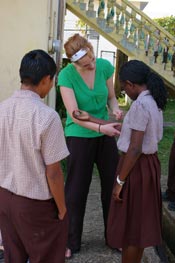
Rachel Wise works with students at the Punta Gorda Methodist School. The group has been teaching students about tools that people with injuries or chronic conditions can use to regain their mobility.
First, the homes that we have visited have been just as much of a cultural shock sort of experience as it has been a learning one. We have learned that when we head out on a home visit, you never know what you may encounter.
We have seen everything from cinder-block homes with minimal mattresses on the floor and buckets for a bathroom to multi-room dwellings with full plumbing and stoves.
However, no matter where we have gone, we have been welcomed very warmly into each person’s home. It is as if money is not a factor here. Some people have more money, but the town seems fairly safe. There is more of a sense of community and family, and everyone helps each other survive.
On the other hand, while everyone has a system of support, it has not been uncommon for neighbors to not know one another. How this is possible in such close quarters is unclear to us, but this is just what we have observed.
Our school visits have been somewhat like a comparison between small town and inner-city schools in the U.S. The first school visit at St. Benedict’s was a good example of the appropriate amount of discipline from the teachers. The kids were easy to work with, followed directions and were very polite.
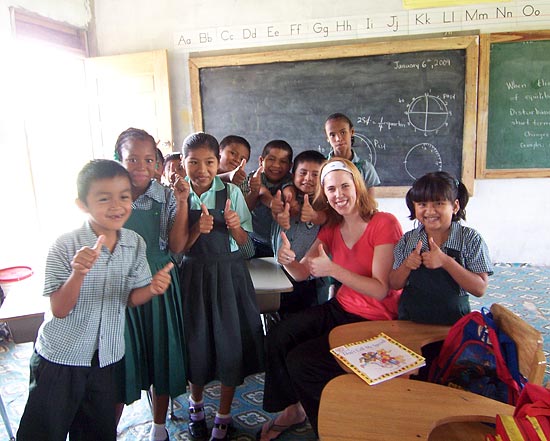
Rachel Wise poses for a class photo with students at St. Bernadette’s School.
As we went to the schools in the town of Punta Gorda, we were warned ahead of time that the students have a reputation for being unruly and wild. We were then instructed to implement strict order and rules in our school visits and gradually allow more freedom if they are behaving well.
This left the impression with some of us students that these children were perhaps “not good kids” or troublemakers, and we went into these other schools with a preconceived notion. We did not find these kids to be any different than children anywhere else. It was more that their instructors did not allow them to be kids and laugh and play as normal children like to do.
For example, it is acceptable here for children to still get lashed on their arms if they misbehave. Also, we noticed in the last school we visited that when the teachers were at our activity stations, the children became silent and were reluctant to engage, but loosened up and responded more freely once the instructors were gone.
Another example was while I was showing the children how to use crutches on some stairs. Some students had difficulty ascending — some of the classmates giggled at the student who was having some trouble, but the teacher immediately stepped in and scolded them for laughing and asked, “When you see someone with crutches on the streets, are you going to laugh at them?” After that, the children did not laugh anymore, but were serious about just going up and down the stairs.
When we visit the schools, yes, we hope that the children learn and take away a message that people with disabilities can do great things and should be treated as any other able-bodied person, but also we hope that they enjoy themselves and have some fun. Not to be a downer and leave the impression that conditions are terrible and people are cruel here, but it is just very different — not necessarily bad or good, just different than my experience in the U.S.
One final commentary on the schools is that everyone wears a uniform, and, in at least two of the schools, the children were not allowed to speak Creole. Schooling is also only reuired through the sixth grade, then if you wish to continue you have to pay.
It seems to me that this would discourage further education past this sixth-grade level and it has not appeared, so far, that education is much of a priority around here. Many people mostly work odd jobs to support their family. For example, our tour guide through the Blue Creek Cave was a farmer, a tour guide and a spelunker, demonstrating that study of a specific trade is not necessary as you will likely have many odd jobs throughout your life. He even appeared very well off in comparison to many of the other families we have seen.
If only there was a way for more people to get encouragement to continue with their education — especially considering the need for skilled workers, such as nurses, doctors and especially special-education teachers. Perhaps if there was more of this focus on education, some of those who are really in need could be better served in the community.
OK, I’m not sure how to end this, but we have to head to another school visit. I hope this better paints a picture of what we have observed.
Until next time,
Sally
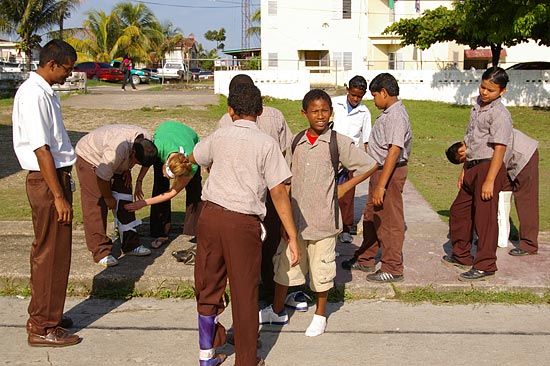
Students from the Punta Gorda Methodist School.
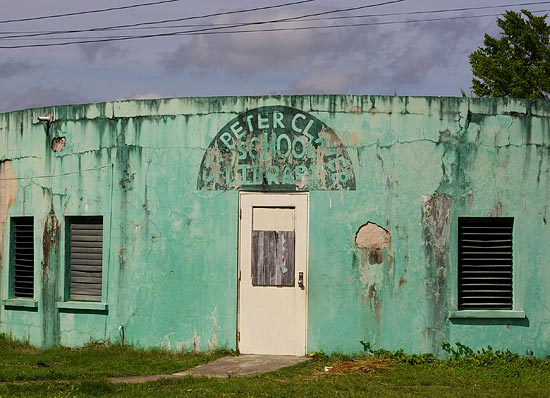
The library at St. Peter Claver School outside Punta Gorda.
Jan. 8
Yesterday (Jan. 7), we visited Punta Gorda Methodist School to do another presentation about disabilities.
The children were around 14 years old. All the kids were very excited to try out the wheelchair and crutches. Many of the students have grandparents or other family members using them at home. They practiced and played in them on the sidewalks and some could pop some awesome wheelies!
All of them were very excited to try out a steep ramp in the wheelchair and stairs with the crutches. While watching the video, students were very interactive and excited about discussing the topic.
The most amusing part of the school visits is that the students aren’t allowed to call us by our first names only. So we are known as Miss Becca, Mr. Ed, Miss Rachel and Miss Sally!
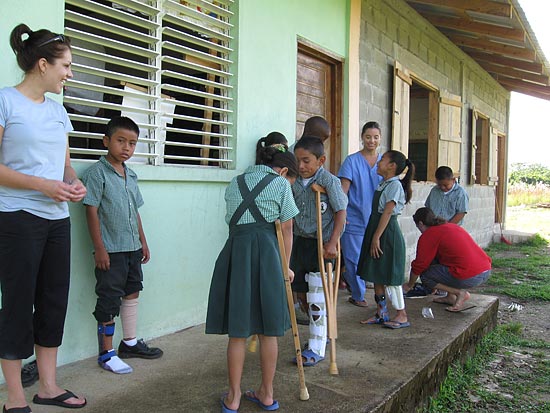
Students at Punta Gorda Methodist School try out crutches as part of a presentation about disabilities.
In addition to the school sessions, we have also been participating in home visits to individuals in the community. So far we have seen children with varying diagnoses, including seizure disorders, cerebral palsy and severe autism. We also have seen some adults, including a woman with severe rheumatoid arthritis and a gentleman recovering from a stroke. So far all the patients and their families have been very receptive and welcoming. As students, we have found this to be a very rewarding experience.
To end the day today we led a discussion on stroke. Much of the information seemed helpful to the community members, and they were eager to ask questions to help better understand stroke. A hot topic of discussion was how to start and maintain an exercise program and modify their diet due to the fact that much of their food is fried. We helped them all to calculate their target heart rate and gave them tips for safe exercising in this hot weather!
Our time here is not all work, of course! Some of the amazing things we have had the chance to try are papaya milkshakes, fresh lime juice (Lori is becoming an expert in the science of lime juice-making) and Johnny cakes. We also occasionally relax with a stroll along the coast! Life is good!
Wish you were here!
Miss Becca, Mr. Ed (get it…haha!), Miss Rachel and Miss Sally
Jan. 8
Our accommodations are very nice, especially by Belize standards — where most families live in space about the size of a residence hall room. The Abby House where we are staying was just dedicated in November. It is named for a visiting resident (physician) Abigail Drake Brinkman.
She died in 2005 while she was in Belize. Abby was a fourth-year medical student. Her family raised the money to build the facility. The house has eight bedrooms, four toilets and four showers. It has a large communal kitchen where we have cooked most of our meals. We are currently sharing the Abby House with four visiting medical students, a pharmacy student, a physician assistant and another physical therapist.
UW-Madison will be sending a pharmacy student to the Hillside Clinic in February. The current pharmacy student is from Drake University and has started creating a log of all the pharmaceuticals in the clinic so the next pharmacy student will have a solid bank of information for the future.
Today was the first open clinic. Local residents began waiting in line to be seen around 7 a.m. The clinic opens at 8 a.m. Many people have to ride a bus for two or more hours to be seen by a medical practitioner. More than 35 people were seen in the morning alone!
I will send some photos of local homes and the Hillside Clinic and the Abby House to demonstrate the differences.
It feels like there is so much that could be done here. There are big things — like improving the hospital and implementing a better sewer system or a more structured system for education. And there are small things — like getting maps for teachers to use when teaching.
It brings into focus very clearly the privilege and plenty I take for granted in the U.S. It begins to get overwhelming — where do you start?
The wonder on this trip has definitely been the children. Wherever you go, children bring people together. It could be parents caring about their children or local teachers desperately wanting resources to better educate the children. But the children do not know the difference. They move through their days laughing and smiling as children do everywhere. There is a quote that is one of my favorites: “Children are the future, teach them wisely.” That is a powerful truth here.
Lori
Jan. 7
Yesterday (Jan. 6) we went to St. Bernadette’s Roman Catholic School. It is located in a small village outside Punta Gorda (in southern Belize). The UW–Madison students met with one class and introduced the topic of disabilities.
The grade-school students were given the opportunity to try operating a wheelchair, walking with crutches and leg splints. They were also read a story about living with disabilities, and a video was shown depicting a young man from Ghana who was disabled.
The teachers were so open and appreciative of our efforts, as were the children. This is a community with very few financial resources. We are visiting four schools while we are here. The teachers have so little to work with in terms of maps or charts. Most have created maps on fabric and diagram charts on paper to illustrate parts of the body or different countries.
Some children with disabilities have been integrated into the classroom, but the teachers have very little specific training for many of the conditions they see.
Last night, the students offered a program on autism to the community.
Most in attendance had a child with autism. Again — the community is eager to learn and engage in any way to assist their sons or daughters.
Today it is 95 degrees, although they say it feels like 115! Will try to have the students write more about their home visits tonight!
Lori
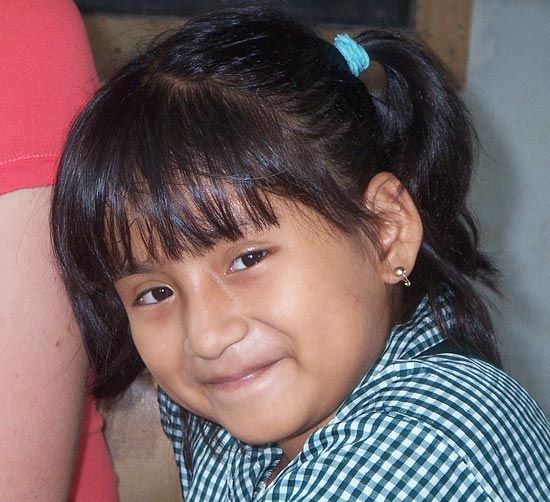
A student at St. Bernadette’s Roman Catholic School in Belize, where UW students and faculty visited on Jan. 6 to talk about people with disabilities.
Jan. 5, 2009
We arrived in Punta Gorda, Belize, via a three-hour van ride over mountainous roads and single-lane bridges. The plan is to work with the Hillside Clinic to offer physical therapy and educational sessions to benefit the entire community.
Our first day consisted of a tour of the only hospital and the local medical clinic. It was an eye-opening experience.
The hospital was run down and primitive by American standards. It was separated into small, one-room wards, including men’s, women’s, maternity and pediatric. Each ward included approximately eight beds. There was also a fairly recent emergency unit addition. The only ward housing patients was the maternity ward. Some beds didn’t include mattresses; tiles were missing from the ceiling; and floor tiles were cracked and loose. The only way to the second floor and all of the wards was a steep cement ramp. Evaluative capabilities included plain films, lab work and ultrasound. Care between the hospital and clinic is closely tied with one pharmacy to serve both. If more advanced health care is necessary, patients are taken by ambulance to the nearest hospital two hours away. Air transportation surprisingly takes longer than by land.
The health care system is very complicated, and our guide stated that most Belizean people do not understand how it works. The National Health Insurance (NHI) program was started to increase the quality of service to patients. There are four available clinics in the Toledo district, and if patients need services, they must attend the clinic in their zone. If patients go to a clinic not in their zone, they will be seen last or not at all. This is due to the fact that reimbursement is only given for patients seen in the correct zone. Things not covered in the NHI program are hospital services without a previous referral; home care and rehabilitation; counseling, drug and alcohol abuse treatment; dialysis; hip replacements/prosthesis; dental care; MRI; or emergency transportation.
After our tour, we stopped by the local market to buy veggies, potatoes, fruit and chicken. Although everything is very fresh, you never know quite what you are going to get. For example, some nice greens were accompanied by an army of ants. Needless to say, we did not indulge in the ants.
We’re sure we will have more stories to share in the days to come!
Farewell from Belize,
Becca, Ed, Rachel and Sally

Participants on the Belize service-learning trip.

